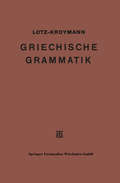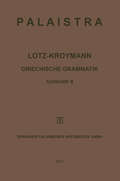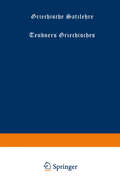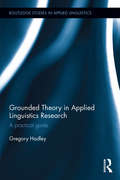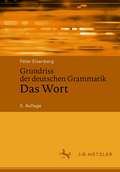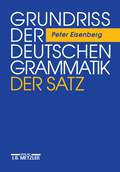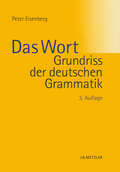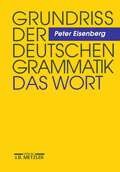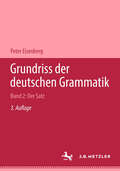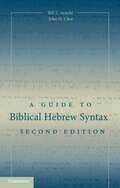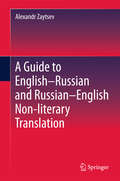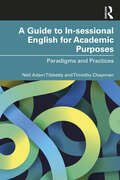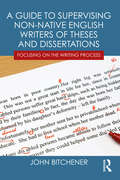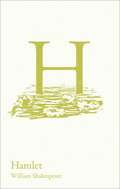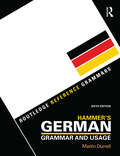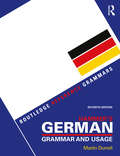- Table View
- List View
Griechische Formenlehre. Griechische Satzlehre (Teubners Griechisches Unterrichtswerk)
by Ernst Lotz Emil KroymannDieser Buchtitel ist Teil des Digitalisierungsprojekts Springer Book Archives mit Publikationen, die seit den Anfängen des Verlags von 1842 erschienen sind. Der Verlag stellt mit diesem Archiv Quellen für die historische wie auch die disziplingeschichtliche Forschung zur Verfügung, die jeweils im historischen Kontext betrachtet werden müssen. Dieser Titel erschien in der Zeit vor 1945 und wird daher in seiner zeittypischen politisch-ideologischen Ausrichtung vom Verlag nicht beworben.
Griechische Grammatik: Formenlehre / Satzlehre
by Ernst Lotz Emil Kroymann W. Hartke Wilhelm SandmannDieser Buchtitel ist Teil des Digitalisierungsprojekts Springer Book Archives mit Publikationen, die seit den Anfängen des Verlags von 1842 erschienen sind. Der Verlag stellt mit diesem Archiv Quellen für die historische wie auch die disziplingeschichtliche Forschung zur Verfügung, die jeweils im historischen Kontext betrachtet werden müssen. Dieser Titel erschien in der Zeit vor 1945 und wird daher in seiner zeittypischen politisch-ideologischen Ausrichtung vom Verlag nicht beworben.
Griechische Satzlehre
by Lotz-KrohmannDieser Buchtitel ist Teil des Digitalisierungsprojekts Springer Book Archives mit Publikationen, die seit den Anfängen des Verlags von 1842 erschienen sind. Der Verlag stellt mit diesem Archiv Quellen für die historische wie auch die disziplingeschichtliche Forschung zur Verfügung, die jeweils im historischen Kontext betrachtet werden müssen. Dieser Titel erschien in der Zeit vor 1945 und wird daher in seiner zeittypischen politisch-ideologischen Ausrichtung vom Verlag nicht beworben.
Grounded Theory in Applied Linguistics Research: A practical guide (Routledge Studies in Applied Linguistics)
by Gregory HadleyThis volume demystifies the procedures and practical uses of Grounded Theory, a well-established research methodology used around the world today by social scientists, teachers, and qualitative researchers. Intended for graduate students, supervisors, and researchers, it provides readers with the tools for understanding, justifying, and disseminating new theoretical insights for the Applied Linguistics community and beyond.
Grounded Theory in Applied Linguistics Research: A practical guide (Routledge Studies in Applied Linguistics)
by Gregory HadleyThis volume demystifies the procedures and practical uses of Grounded Theory, a well-established research methodology used around the world today by social scientists, teachers, and qualitative researchers. Intended for graduate students, supervisors, and researchers, it provides readers with the tools for understanding, justifying, and disseminating new theoretical insights for the Applied Linguistics community and beyond.
Grundriss der deutschen Grammatik: Das Wort
by Peter EisenbergStandardwerk zur deutschen Grammatik, das Verständlichkeit mit Forschungsnähe und begrifflicher Präzision verbindet. Die Darstellung in zwei Bänden folgt der seit langem bewährten Gliederung in Wort- und Satzgrammatik. Beide Bände sind inhaltlich eng aufeinander bezogen, aber dennoch unabhängig voneinander verwendbar. Der Grundriss hat sich in der universitären Lehre ebenso bewährt wie im Selbststudium. Mit über 200 Arbeitsaufgaben und zugehörigen Lösungen regt er zu selbständiger grammatischer Analyse an. „Das Wort“ fächert die Wortgrammatik des Deutschen in ihre großen Themenfelder auf: Phonetik und Phonologie, Morphologie und Orthografie.
Grundriss der deutschen Grammatik: Band 2: Der Satz
by Peter EisenbergDer vorliegende Band gibt eine umfassende Einführung in die Formen- und Satzlehre des Deutschen. Besonderer Wert ist auf begriffliche Präzision und Verständlichkeit gelegt. Mit über 200 Arbeitsaufgaben zum Selbststudium.
Grundriss der deutschen Grammatik: Band 2: Der Satz
by Peter EisenbergStandardwerk zur deutschen Grammatik verständlich geschrieben und instruktiv. Der Grundriss der deutschen Grammatik greift zwei Säulen auf: das Wort und den Satz . Die beiden Teilbände ergänzen sich und sind zugleich unabhängig voneinander einsetzbar. Präzise und gut verständlich wird die gesamte Grammatik ausgebreitet. Rund 200 Aufgaben und Lösungen führen differenzierte Analysewege vor. Ein umfassendes Lehrwerk, das sich auch bestens für das Selbststudium eignet. Der Satz führt systematisch in die Formen- und Satzlehre des Deutschen ein. In übersichtliche Lerneinheiten gegliedert, berücksichtigt das Lehrbuch alle wesentlichen Aspekte.
Grundriß der deutschen Grammatik: Band 2: Der Satz
by Peter EisenbergWort und Satz gelten als kommunikative Säulen, die die vollständige Grammatik einer Sprache tragen. Der 'Grundriß der deutschen Grammatik' greift diese Zweigliederung auf. Die Teilbände 'Das Wort' und 'Der Satz' ergänzen sich und sind zugleich unabhängig voneinander einsetzbar. Präzise und gut verständlich werden die gesamte Grammatik und die wissenschaftlichen Kernfragen ausgebreitet. Rund 200 Aufgaben und Lösungen führen differenzierte Analysewege vor. Ein glänzendes Lehrbuch, auch für das Selbststudium geeignet. Der Teilband 'Der Satz' führt systematisch in die Formen- und Satzlehre des Deutschen ein. In übersichtliche Lerneinheiten gegliedert, lässt das Lehrbuch keinen Aspekt außer Acht. Neu: Umfassende Analysen zum Genitivobjekt.
Grundriss der deutschen Grammatik: Band 1: Das Wort
by Peter EisenbergStandardwerk zur deutschen Grammatik verständlich geschrieben und instruktiv. Der Grundriss der deutschen Grammatik greift zwei Säulen auf: das Wort und den Satz . Die beiden Teilbände ergänzen sich und sind zugleich unabhängig voneinander einsetzbar. Präzise und gut verständlich wird die gesamte Grammatik ausgebreitet. Rund 200 Aufgaben und Lösungen führen differenzierte Analysewege vor. Ein umfassendes Lehrwerk, das sich auch bestens für das Selbststudium geeignet. Das Wort fächert die Wortgrammatik des Deutschen in ihre großen Themenfelder auf: Phonetik und Phonologie, Morphologie und Orthografie.
Grundriss der deutschen Grammatik: Band 1: Das Wort
by Peter EisenbergWort und Satz gelten als kommunikative Säulen einer Sprache. Der 'Grundriss der deutschen Grammatik' greift diese Zweigliederung auf. Die Teilbände 'Das Wort' und 'Der Satz' ergänzen sich und sind zugleich unabhängig voneinander einsetzbar. Präzise und gut verständlich wird die gesamte Grammatik ausgebreitet. Rund 200 Aufgaben und Lösungen führen differenzierte Analysewege vor. Ein glänzendes Lehrbuch, auch für das Selbststudium geeignet. Der Teilband 'Das Wort' fächert die Wortgrammatik des Deutschen in ihre großen Themenfelder auf: Phonetik und Phonologie, Morphologie und Orthografie.
Grundriss der deutschen Grammatik: Band 1: Das Wort
by Peter EisenbergDer vorliegende Band gibt eine umfassende Einführung in die Wortgrammatik des Deutschen - Phonetik, Phonologie, Flexions- und Wortbildungslehre, Orthographie. Mit über 200 Arbeitsaufgaben zum Selbststudium.
Grundriss der deutschen Grammatik: Band 2: Der Satz
by Peter EisenbergWort und Satz gelten als kommunikative Säulen einer Sprache. Der 'Grundriss der deutschen Grammatik' greift diese Zweigliederung auf. Die Teilbände 'Das Wort' und 'Der Satz' ergänzen sich und sind zugleich unabhängig voneinander einsetzbar. Präzise und gut verständlich wird die gesamte Grammatik ausgebreitet. Rund 200 Aufgaben und Lösungen führen differenzierte Analysewege vor. Ein glänzendes Lehrbuch, auch für das Selbststudium geeignet. Der Teilband 'Der Satz' führt systematisch in die Formen- und Satzlehre des Deutschen ein. In übersichtliche Lerneinheiten gegliedert, lässt das Lehrbuch keinen Aspekt außer Acht.
Grundriss der deutschen Grammatik: Der Satz
by Peter Eisenberg Rolf SchöneichStandardwerk zur deutschen Grammatik, das Verständlichkeit mit Forschungsnähe und begrifflicher Präzision verbindet. Die Darstellung in zwei Bänden folgt der seit langem bewährten Gliederung in Wort- und Satzgrammatik. Beide Bände sind inhaltlich eng aufeinander bezogen, aber dennoch unabhängig voneinander verwendbar. Der Grundriss hat sich in der universitären Lehre ebenso bewährt wie im Selbststudium. Mit über 200 Arbeitsaufgaben und zugehörigen Lösungen regt er zu selbständiger grammatischer Analyse an. „Der Satz“ führt systematisch in die Formen- und Satzlehre des Deutschen ein.
A Guide To Biblical Hebrew Syntax: (PDF)
by Bill T. Arnold John H. ChoiA Guide to Biblical Hebrew Syntax introduces and abridges the syntactical features of the original language of the Hebrew Bible/Old Testament. An intermediate-level reference grammar for Biblical Hebrew, it assumes an understanding of elementary phonology and morphology, and it defines and illustrates the fundamental syntactical features of Biblical Hebrew that most intermediate-level readers struggle to master. The volume divides Biblical Hebrew syntax and morphology into four parts. The first three cover the individual words (nouns, verbs, and particles) with the goal of helping the reader move from morphological and syntactical observations to meaning and significance. The fourth section moves beyond phrase-level phenomena and considers the larger relationships of clauses and sentences. Since publication of the first edition, research on Biblical Hebrew syntax has substantially evolved. This new edition incorporates these developments through detailed descriptions of grammatical phenomena from a linguistics approach. It retains the labels and terminology used in the first edition to maintain continuity with the majority of entry-level and more advanced grammars.
A Guide to English–Russian and Russian–English Non-literary Translation
by Alexandr ZaytsevLying at the intersection of translatology, cognitive science and linguistics, this brief provides a comprehensive framework for studying, investigating and teaching English-Russian/Russian-English non-literary translation. It provides a holistic perspective on the process of non-literary translation, illustrating each of its steps with carefully analyzed real-life examples. Readers will learn how to choose and process multidimensional attention units in original texts by activating different types of knowledge, as well as how to effectively devise target-language matches for them using various translation techniques. It is rounded out with handy and feasible recommendations on the structure and content of an undergraduate course in translation. The abundance of examples makes it suitable not only for use in the classroom, but also for independent study.
A Guide to In-sessional English for Academic Purposes: Paradigms and Practices
by Neil Adam Tibbetts Timothy ChapmanA hands-on guide for practitioners, this book prepares instructors to teach in-sessional English for Academic Purposes (ISEAP) higher education courses. As university cohorts become more diverse, there is demand for in-sessional EAP courses not only to support international students, but also increasingly as a provision for all students. This informative resource explores the varying formats of ISEAP courses and how they are embedded within and alongside students’ degree programmes in the United Kingdom and beyond. In accessible chapters, authors Neil Adam Tibbetts and Timothy Chapman present illuminating findings drawn from interviews conducted with experts in the field and highlight the challenges that students and practitioners face. Avoiding prescriptive recommendations, Tibbetts and Chapman address different models and contexts of ISEAP courses at the university level and offer guidance and tools for practice. Covering key topics such as pedagogies, logistical challenges, and the wider university context, this book not only provides a roadmap to the often ill-defined but essential domain of ISEAP but also provokes questions and ideas for further reflection, guiding the reader towards a deeper understanding of their role and development in context. Engaging and inviting, Tibbetts and Chapman’s helpful text is a necessary resource for teachers to design and lead successful ISEAP courses.
A Guide to In-sessional English for Academic Purposes: Paradigms and Practices
by Neil Adam Tibbetts Timothy ChapmanA hands-on guide for practitioners, this book prepares instructors to teach in-sessional English for Academic Purposes (ISEAP) higher education courses. As university cohorts become more diverse, there is demand for in-sessional EAP courses not only to support international students, but also increasingly as a provision for all students. This informative resource explores the varying formats of ISEAP courses and how they are embedded within and alongside students’ degree programmes in the United Kingdom and beyond. In accessible chapters, authors Neil Adam Tibbetts and Timothy Chapman present illuminating findings drawn from interviews conducted with experts in the field and highlight the challenges that students and practitioners face. Avoiding prescriptive recommendations, Tibbetts and Chapman address different models and contexts of ISEAP courses at the university level and offer guidance and tools for practice. Covering key topics such as pedagogies, logistical challenges, and the wider university context, this book not only provides a roadmap to the often ill-defined but essential domain of ISEAP but also provokes questions and ideas for further reflection, guiding the reader towards a deeper understanding of their role and development in context. Engaging and inviting, Tibbetts and Chapman’s helpful text is a necessary resource for teachers to design and lead successful ISEAP courses.
A Guide to Supervising Non-native English Writers of Theses and Dissertations: Focusing on the Writing Process
by John BitchenerFocused on the writing process, A Guide to Supervising Non-native English Writers of Theses and Dissertations presents approaches that can be employed by supervisors to help address the writing issues or difficulties that may emerge during the provisional and confirmation phases of the thesis/dissertation journey. Pre-writing advice and post-writing feedback that can be given to students are explained and illustrated. A growing number of students who are non-native speakers of English are enrolled in Masters and PhD programmes at universities across the world where English is the language of communication. These students often encounter difficulties when writing a thesis or dissertation in English – primarily, understanding the requirements and expectations of the new academic context and the conventions of academic writing. Designed for easy use by supervisors, this concise guide focuses specifically on the relationship between reading for and preparing to write the various part-genres or chapters; the creation of argument; making and evaluating claims, judgements and conclusions; writing coherent and cohesive text; meeting the generic and discipline-specific writing conventions; designing conference abstracts and PowerPoint presentations; and writing journal articles.
A Guide to Supervising Non-native English Writers of Theses and Dissertations: Focusing on the Writing Process
by John BitchenerFocused on the writing process, A Guide to Supervising Non-native English Writers of Theses and Dissertations presents approaches that can be employed by supervisors to help address the writing issues or difficulties that may emerge during the provisional and confirmation phases of the thesis/dissertation journey. Pre-writing advice and post-writing feedback that can be given to students are explained and illustrated. A growing number of students who are non-native speakers of English are enrolled in Masters and PhD programmes at universities across the world where English is the language of communication. These students often encounter difficulties when writing a thesis or dissertation in English – primarily, understanding the requirements and expectations of the new academic context and the conventions of academic writing. Designed for easy use by supervisors, this concise guide focuses specifically on the relationship between reading for and preparing to write the various part-genres or chapters; the creation of argument; making and evaluating claims, judgements and conclusions; writing coherent and cohesive text; meeting the generic and discipline-specific writing conventions; designing conference abstracts and PowerPoint presentations; and writing journal articles.
HAMLET: (PDF)
by William Shakespeare and Collins GCSE Edited by Peter Alexander Introduction and notes by Lucy ToopThis edition of Hamlet is perfect for A-level students, with the complete play in an accessible format, on-page notes, introduction setting the context, timeline, character and theme indexes. Affordable high quality complete play for Hamlet Demystify vocabulary with notes on the page and concise commentary Set the scene with perfectly pitched introductions that introduce key contexts, concerns and stylistic features, and examine different performances and interpretations Recall plot summaries at the beginning of each scene Support A Level revision and essay writing with theme and character indexes Help with social, historical and literary context with the bespoke timeline of Shakespeare’s life and times
Hammer's German Grammar and Usage (Routledge Reference Grammars)
by Martin DurrellLong trusted as the most comprehensive, up-to-date and user-friendly grammar available, Hammer’s German Grammar provides you with a complete guide to German as it is written and spoken today. In a new layout to enable better referencing, this new edition includes: concise descriptions of the main grammatical phenomena of German and their use examples of grammar taken from contemporary German, helping you to understand the underlying grammatical principles more quickly invaluable guidance on pronunciation and the German accent discussion of new words from English roots, helping you to communicate in German as Germans do today clarification on the spelling reform and current spellings of German, thus increasing your confidence while writing and reading in German. Praised for its lucid explanations, this new edition distinguishes the most common forms of usage, both formal and informal. Hammer’s German Grammar also offers you a combination of reference grammar and manual of current usage that you will find invaluable, whether a student or a teacher, at intermediate or advanced level.
Hammer's German Grammar and Usage (Routledge Reference Grammars)
by Martin DurrellLong trusted as the most comprehensive, up-to-date and user-friendly grammar available, Hammer’s German Grammar and Usage provides you with a complete guide to German as it is written and spoken today. In a revised layout to improve ease of consultation, this new edition includes: concise descriptions of the main grammatical phenomena of German and their use completely reorganized tables of grammatical features examples of grammar taken from contemporary German, helping you to understand the underlying grammatical principles more quickly invaluable guidance on pronunciation and word stress discussion of new words from English roots, helping you to communicate in German as Germans do today clarification on current spellings of German with full detail on the most recent revisions to the rules list of useful internet resources for students, teachers and all learners of German Praised for its lucid explanations, this new edition explains and clearly distinguishes formal and informal spoken and written usage. Hammer’s German Grammar offers you a combination of reference grammar and manual of current usage that you will find invaluable, whether a student or a teacher, at intermediate or advanced level.
Hammer's German Grammar and Usage (Routledge Reference Grammars)
by Martin DurrellLong trusted as the most comprehensive, up-to-date and user-friendly grammar available, Hammer’s German Grammar and Usage provides you with a complete guide to German as it is written and spoken today. In a revised layout to improve ease of consultation, this new edition includes: concise descriptions of the main grammatical phenomena of German and their use completely reorganized tables of grammatical features examples of grammar taken from contemporary German, helping you to understand the underlying grammatical principles more quickly invaluable guidance on pronunciation and word stress discussion of new words from English roots, helping you to communicate in German as Germans do today clarification on current spellings of German with full detail on the most recent revisions to the rules list of useful internet resources for students, teachers and all learners of German Praised for its lucid explanations, this new edition explains and clearly distinguishes formal and informal spoken and written usage. Hammer’s German Grammar offers you a combination of reference grammar and manual of current usage that you will find invaluable, whether a student or a teacher, at intermediate or advanced level.
